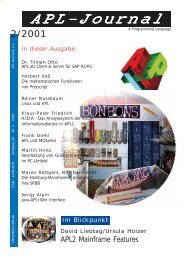APL-Journal - APL Germany e. V.
APL-Journal - APL Germany e. V.
APL-Journal - APL Germany e. V.
You also want an ePaper? Increase the reach of your titles
YUMPU automatically turns print PDFs into web optimized ePapers that Google loves.
<strong>APL</strong>-<strong>Journal</strong><br />
(A question that has different answers on different hardware<br />
platforms.)<br />
4. Data is nested.<br />
An array is a rectangular collection of numbers, characters<br />
and other arrays.<br />
5. Operators can apply array functions in organized ways.<br />
<strong>APL</strong> distinguishes between functions (that operate on arrays)<br />
and operators (that operate on functions. For example,<br />
the mathematical operation of Summation is often<br />
represented by this Mathematical expression:<br />
But if you think of summation as the conceptual operation<br />
„add up this list of numbers“, <strong>APL</strong>s notation for it is<br />
much cleaner<br />
+/A<br />
The pseudo variables „i and „n“ only clutter up the concept.<br />
If „A“ is an „n“ item vector, the addition function is<br />
applied „n-1“ times. The structure of the data determfsines<br />
how many time operations are applied – not constructions<br />
that the programmer (or mathematician) write.<br />
This makes programs shorter, easier to understand, and<br />
easier to modify.<br />
6. <strong>APL</strong> is interpreted<br />
<strong>APL</strong> expressions are parsed and evaluated at execution<br />
time. While there are <strong>APL</strong> compilers, they typically put<br />
restrictions on the kinds of expressions that can be used.<br />
This interpretation used to cause people to think that <strong>APL</strong><br />
must be slow because it is not compiled. That was never<br />
true of <strong>APL</strong> programs written to use its array power because<br />
each operation of an expression could operate on<br />
so much data. Because <strong>APL</strong> programs are small, the interpretive<br />
overhead is negligible. Now that Java is a popular<br />
language and Java programs run on a virtual machine, this<br />
kind of overhead is no longer a concern to people.<br />
It’s interesting that this paper is written in anticipation of<br />
the 40 th anniversary of the first <strong>APL</strong> workspace<br />
(1 CLEANSPACE) and a program that someone wrote<br />
40 years ago will run on any modern <strong>APL</strong> system today<br />
without a recompilation. Can any other programming language<br />
make that claim?<br />
7. Expressions can be evaluated interactively<br />
<strong>APL</strong> expressions are immediately executed so it is possible<br />
to play with your data and discover the algorithm. If<br />
you already know exactly what you need to do, this is not<br />
important but that is not a common occurrence.<br />
8. <strong>APL</strong> is symbolic<br />
<strong>APL</strong> uses mathematical looking symbols to represent its<br />
operations. This makes <strong>APL</strong> expressions very short and<br />
enables the recognition of common idioms at a glance.<br />
Ultimately, the symbolic nature of <strong>APL</strong> may be one of<br />
the problems with the notation that limit its growth. <strong>APL</strong><br />
programs look more difficult than they are when compared<br />
to, for example, a program in Visual BASIC. But<br />
this is because one line of Visual BASIC says so little.<br />
Furthermore, <strong>APL</strong> requires special fonts (no longer a problem)<br />
and special keyboards (still a problem).<br />
All this is important because it empowers the person who<br />
programs in <strong>APL</strong>. A single person can implement a significant<br />
algorithm and deploy it to others in the company. The<br />
most successful companies that use <strong>APL</strong> make sure this is<br />
controlled and accomplished with good software engineering<br />
practice including documentation. Companies that allow<br />
undisciplined deployment of <strong>APL</strong> applications find years later<br />
that they have applications that are not maintainable and<br />
cannot be enhanced easily. <strong>APL</strong> gets a bad reputation at these<br />
companies.<br />
What comes next?<br />
When programmers have the productivity of a notation<br />
like <strong>APL</strong>, they do not respond positively to attempts to move<br />
to some newer but less productive offering. Many companies<br />
whose IT leaders did not understand the productivity of<br />
array programming mandated moving off of <strong>APL</strong> and have<br />
failed or have spent a lot of money and people to succeed.<br />
<strong>APL</strong> is hard to beat as a programming language for algorithms<br />
but algorithms are not the only task of a business<br />
programmer. You also have to build user interfaces and you<br />
have to access databases and files and networks. You have to<br />
have version management and configuration management.<br />
The modern tools for these tasks are wonderful and productive<br />
and largely unavailable to the <strong>APL</strong> programmer.<br />
Wouldn’t it be nice if you could have it all? Array programming<br />
for algorithms; productive tools for user interfac-<br />
<strong>APL</strong> - <strong>Journal</strong> 2006, 25. Jg., Heft 1/2 17



